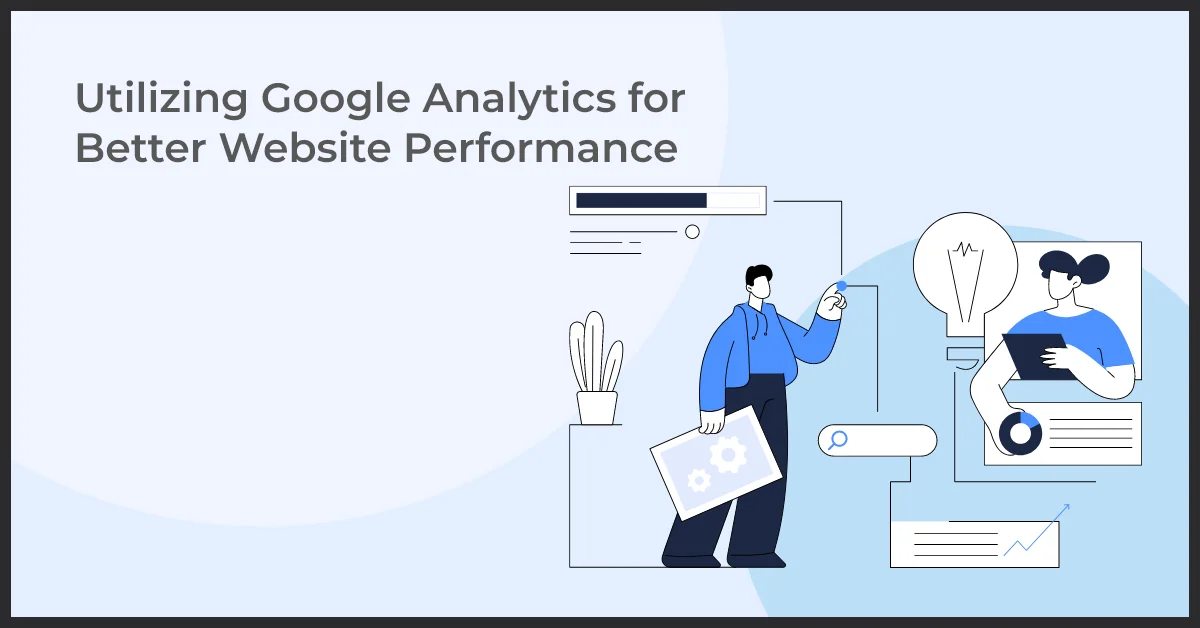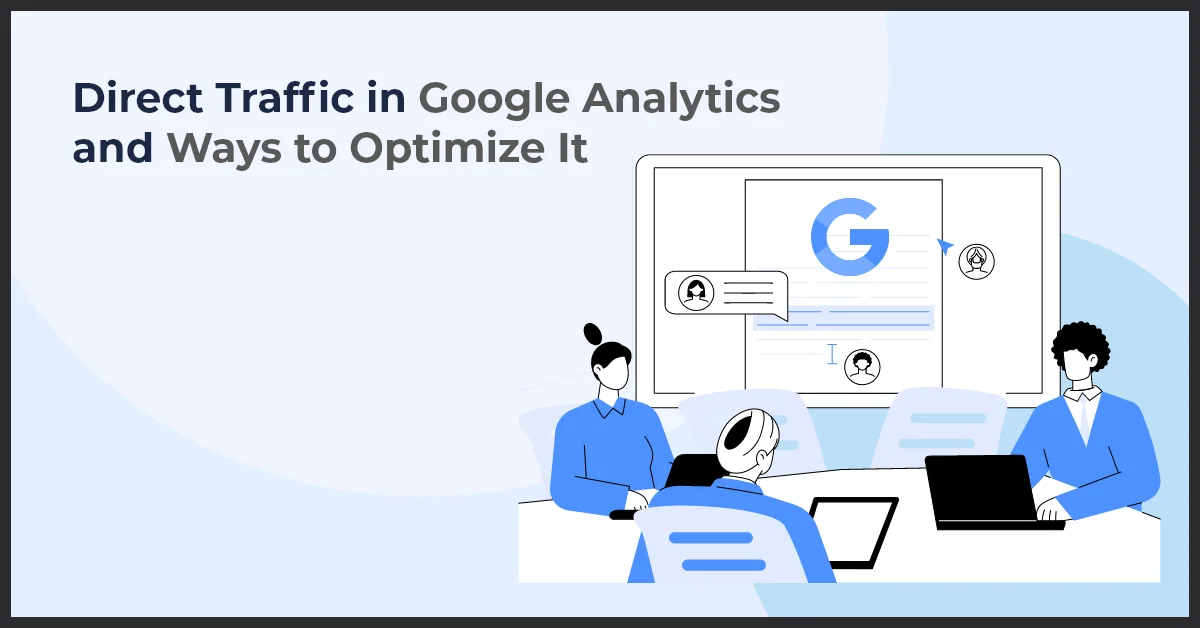Utilizing Google Analytics for Better Website Performance

Published on: June 30, 2023
Updated on: July 08, 2024
1185 Views
- Analytics
11 min read
Picture yourself as the genius behind a big carnival, enticing guests with your technological marvels. You want to capture their attention, understand their desires, and take them on an enthralling trip. This is where Google Analytics comes in like a cyclone, armed with the power to unlock the mysteries of your virtual world.
Google Analytics, reveals your audience's hidden pulse, showing the depths of their aspirations and the intricacies of their behavior. It provides a front-row ticket to the symphony of clicks, scrolling, and conversions that takes place on the stage of your website.
As you explore Google Analytics, you'll uncover a treasure mine of insights that will elevate your website from a basic digital presence to an amazing experience. So, let’s delve into the world of Google Analytics and explore how it can be effectively utilized to enhance your website's performance.
Tracking Website Performance Metrics in Google Analytics
Website performance metrics serve as the compass that guides you through the vast landscape of your online presence. With Google Analytics as your trusty companion, you can unlock a wealth of data-driven insights to optimize your website's performance. Let's explore some essential metrics that will shape your path to success.
User Behavior and Website Traffic
Learn about the sources of your website traffic, such as organic search, social media, and referrals. Understand user behavior using analytics like as page views, session length, and bounce rates, which can help you tweak your content and create an engaging user experience.
Conversion Rates and Goal Completions
Set up objectives in Google Analytics to analyze conversions and evaluate campaign efficiency. Identify high-converting pages and optimize your techniques to enhance conversion rates and meet the goals of your website.
Page Load Time and Bounce Rate
Monitor bounce rates to determine visitor engagement and potential issues with your website. Improve user experience, minimize bounce rates, and keep visitors engaged with your content by optimizing page load speeds.
User Experience and Mobile Performance
Examine how mobile users engage with your website. Analyze analytics such as mobile bounce rates, conversion rates, and user behavior to maintain a consistent and user-friendly experience across many screen sizes while increasing engagement and conversions.
Optimizing Website Performance with Google Analytics Insights
Google Analytics offers insightful data that can be used to improve the functionality of your website. You can improve the efficiency of your website and more successfully engage consumers by utilizing this information. Here’s what you can do with these insights:
Analyzing User Behavior
Check for metrics for user activity such as time on page, click-through rates, and exit pages. Recognize patterns and trends to better understand how visitors interact with your website. You can use this insight to make educated decisions to optimize navigation, simplify user flows, and improve the overall user experience.
Identifying High-Performing Pages and Content
Use Google Analytics to determine which pages and content create the most interaction and conversions. To identify what connects with your audience, examine indicators like page visits, average session time, and goal completions. Use this data to duplicate success throughout your website, improve underperforming pages, and create engaging content that keeps users coming back for more.
Examining Conversion Funnels and Optimizing Conversion Paths
Analyze conversion funnels in Google Analytics to learn where visitors leave the conversion process. Identify any bottlenecks, friction areas, or diversions that can be impeding conversions. Optimize your conversion routes by reducing forms, enhancing calls to action, and creating a unified experience that encourages visitors to do the necessary activities.
Monitoring and Improving Website Speed and Performance
Google Analytics provides useful information on page load times and site performance. Monitor these metrics to detect portions of your website that might be slow. Slow-loading websites can result in high bounce rates and dissatisfied visitors. Optimize the speed of your website by compressing pictures, minifying code, and utilizing caching techniques to provide a quicker and smoother user experience.
Using Google Analytics Reports and Tools for Website Optimization
Google Analytics offers a plethora of reports and tools that can unlock the full potential of your website optimization efforts. Let's explore the key reports and tools.
Audience and User Behavior Reports
Investigate information such as demographics and behavior to better understand the audience for your website. Learn about their age, gender, location, and interests. Analyze analytics related to user activity such as session length, pages per session, and bounce rates.
Acquisition and Traffic Sources Analysis
Using the Acquisition and Traffic Sources reports, you can learn how users reach your website. Determine which channels are responsible for the most traffic and conversions. This study helps you to properly manage resources, optimize marketing efforts, and focus on the most profitable acquisition channels.
Conversion Funnels and Behavior Flow
The Behavior Flow report depicts how visitors explore your website, emphasizing prominent entry and departure locations. Analyzing these reports allows you to enhance overall website performance by optimizing user flows, streamlining conversion pathways, and streamlining conversion paths.
Site Speed and Page Speed Insights
The speed of a website is critical for both user experience and search engine rankings. Site Speed data from Google Analytics indicates page load times, server response times, and page rendering speed. Use these analytics and tools to improve the performance of your website, minimize bounce rates, and keep visitors engaged.
Best Practices for Leveraging Google Analytics for Better Website Performance
To achieve effective optimization of your website's performance, it is crucial to adhere to best practices when utilizing Google Analytics. By implementing these key practices, you can unlock the full potential of this powerful tool. Let's delve into the essential strategies to understand in a better way:
Analyzing Website Performance Metrics
Make it a practice to examine and evaluate your website's performance indicators in Google Analytics regularly. Track important analytics like traffic sources, user activity, conversions, and bounce rates. By keeping a watch on these indicators, you would uncover patterns, identify areas for improvement, and make data-driven choices to optimize the performance of your website.
Tracking Relevant KPIs
Define precise goals for your website and assign KPIs (Key Performance Indicators) to them in Google Analytics. Having clear goals and measuring the correct metrics can help you assess success and focus your efforts on areas that matter most to your company objectives, whether it's boosting conversions, improving engagement, or optimizing user experience.
Utilizing Custom Segments
Custom segments and advanced filters in Google Analytics allow you to slice and dice your data for deeper analysis. Create custom segments to analyze specific user groups or behaviors, such as new visitors, returning customers, or mobile users. Apply advanced filters to exclude internal traffic or focus on specific geographic regions.
Implementing A/B Testing
Leverage Google Analytics to implement A/B testing and experimentation to optimize your website continuously. Test different versions of landing pages, call-to-action buttons, or page layouts to identify what resonates best with your audience. By systematically experimenting and measuring the impact of changes, you can refine your website and deliver an exceptional user experience that drives conversions.
Staying Updated with New Features
Google Analytics evolves continuously, introducing new features and capabilities to enhance data analysis and reporting. Stay updated with the latest developments, attend webinars, and explore resources provided by Google to fully leverage the tool's potential. By staying informed, you can unlock new ways to extract valuable insights and keep up with industry trends.
Understanding Google Analytics Interface and Features
Google Analytics provides a comprehensive interface that allows you to gain valuable insights into your website's performance. By understanding the different sections and features available, you can make data-driven decisions to optimize your online presence.
A. Navigating the Google Analytics dashboard
The Google Analytics dashboard is divided into several sections, each serving a unique purpose:
- Home: Here, you can find an overview of your website's key metrics, including sessions, pageviews, and conversion rate.
- Real-Time: This section shows you live data on your website visitors, including active users, top active pages, and traffic sources.
- Audience: Gain insights into your website visitors' demographics, interests, and behavior.
- Acquisition: Understand where your website traffic is coming from, including organic search, direct visits, referrals, and social media.
- Behavior: Explore how users engage with your website, including bounce rates, average session duration, and top landing pages.
- Conversions: Track and analyze conversion goals, such as completed transactions or form submissions.
B. Overview of Google Analytics features
Google Analytics offers a range of features to help you gain valuable insights:
1. Web analytics
Utilize web analytics to analyze data related to your website visitors, including sessions, bounce rates, and average session duration. By segmenting this data, you can gain a deeper understanding of user behavior.
2. Tracking website traffic
Analyze traffic sources to understand how users find your website, whether through organic search, direct visits, referrals, social media, or other channels. This information is crucial for marketing and SEO strategies.
3. Digital marketing analytics
Track the performance of your marketing campaigns and channels, such as email and social media. By identifying valuable marketing insights, you can optimize your campaigns for better results.
4. Data analysis and reporting
Explore different data visualization options within Google Analytics. Generate customized reports to obtain actionable insights for your business.
5. Website performance optimization
Analyze page load speed to identify optimization opportunities. By improving user experience, you can increase conversions and reduce bounce rates.
6. Conversion rate optimization
Track and analyze conversion funnels to understand where users drop off in the conversion process. Utilize data to optimize website elements and improve conversion rates.
7. E-commerce analytics
Monitor online sales, revenue, and product performance to optimize your e-commerce strategies based on data-driven insights.
8. User behavior analysis
Explore user demographics, interests, and behavior flow to enhance website usability and engagement.
9. Content analysis and performance
Analyze the performance of different website content, such as blogs and landing pages. Optimize your content based on data-driven insights to drive better results.
10. Google Analytics features and functionalities
Discover advanced features like custom dimensions, filters, and goals. Learn how to set up and utilize these features to gain valuable insights for your business.
Utilizing Google Analytics for Business Success
A. Key metrics and KPIs for measuring success
When it comes to measuring the success of your website, it's crucial to identify and track relevant metrics. Google Analytics provides a wealth of data that can help you understand your site's performance.
By utilizing Google Analytics, you can gain insights into metrics such as:
- Website traffic: Understand how many visitors are coming to your site and where they are coming from.
- Bounce rate: Measure the percentage of visitors who leave your site after viewing only one page. A high bounce rate could indicate issues with your site's user experience.
- Conversion rate: Track the percentage of visitors who completed a desired action, such as making a purchase or filling out a form.
- Page load time: Monitor how quickly your website pages load, as slow loading times can lead to higher bounce rates and decreased user satisfaction.
In addition to tracking metrics, it's important to define key performance indicators (KPIs) that align with your business goals. These KPIs should be specific, measurable, and relevant to your objectives. For example, if your goal is to increase online sales, a relevant KPI could be the conversion rate of your website's checkout process.
B. Data-driven decision-making in business strategies
Data-driven decision-making is crucial in today's highly competitive business landscape. By leveraging the data provided by Google Analytics, you can make informed decisions that have a positive impact on your business.
Google Analytics data can help you:
- Identify trends and patterns: Analyze data over time to uncover trends and patterns in user behavior. This information can guide you in optimizing your website and marketing strategies.
- Improve user experience: By understanding how users navigate your website, you can make improvements to enhance their experience and increase engagement.
- Optimize marketing efforts: Use data on user demographics, traffic sources, and conversions to optimize your marketing campaigns and allocate resources more effectively.
Many successful companies have utilized Google Analytics to improve their return on investment (ROI). For example, by analyzing data on user behavior, an e-commerce company identified that a significant portion of their customers were dropping off during the checkout process. With this insight, they were able to make changes to the checkout flow, resulting in an increase in completed purchases and ultimately, higher revenue.
Conclusion
In today's digital landscape, harnessing the power of Google Analytics is paramount for optimizing website performance. By tracking metrics, analyzing user behavior, optimizing conversion paths, and improving site speed, you can make data-driven decisions. Leveraging Google Analytics reports and tools, setting goals, utilizing custom segments, and staying updated empower you to deliver an exceptional user experience and achieve remarkable results. With Google Analytics as your ally, your website can thrive and leave a lasting impression on your audience.
Wish to Enhance Your Website Performance With the Power of Google Analytics? Talk to Us!
Our certified experts would love to pitch in. Just write to info@growthnatives.com or call +1 855-693-4769 and we’ll take it from there.



